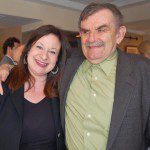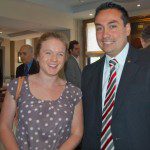WPA’s Bilfield Touts D.C.’s Musical Collaboration
By • June 2, 2014 0 1659

The first time we met Jenny Bilfield, she was just settling into her new job as the president and CEO of what was called the Washington Performing Arts Society.
Even then, we kind of figured that Bilfield, who came to Washington from her job of artistic director of Stanford Live at Stanford University, was a woman well met. She could easily fill a room with her presence, even at a small downtown coffee shop like Bourbons.
That was during late summer 2013, and she’s still filling rooms, charming and inspiring people with her intelligence, down-to-earth warmth, vision and a few other gifts. She was at it again May 22 at the George Town Club, where she appeared at the Georgetown Media Group’s Cultural Leadership Breakfast, one of a series of such talks and gatherings, sponsored by GMG—which publishes The Georgetowner and The Downtowner newspapers—featuring D.C. and Washington area cultural leaders.
Since then, there have been some changes at WPA(S), changes that involve branding—see the single logo W—and the dropping of the letter “S” and word “society.” There’s a new slogan: “We make it happen.” More than that, there’s a self-evident bounce and energy upgrade in what is and has been the area’s and the city’s largest presenting institution for decades.
“It’s been a year now since I’ve been here, and I suppose that you can go about this sort of thing several ways—make big, sweeping changes right away, make a big splash, make your mark, or share in the changes, engage the community at large and our institutional one also,” Bilfield said during her breakfast talk. “I was advised not to try to do anything about branding or the name or anything like that. But then we discovered something in the process of talking and engaging with people. They talked about the name.”
Bilfield said the changes were made to send an inclusive message to broaden Washington Performing Arts’ presence in the community, schools and on a larger scale.
It’s also a measure of Bilfield’s approach to WPA’s mission. When you hear her talk about going into the schools, the WPA gospel choir and its graduates, about pianist Simone Dinnerstein’s involvement in area schools during her last concert here, not only do you understand the importance of education in the performing arts, but you want, like Bilfield, to do something with it and about it.
“What we would like to see is our artists work with local schools and students in some fashion or another,” Bilfield said. “That’s not possible all of the time, but when it is, you have something special.”
She’s also a believer in cooperative efforts and creating partnerships among disciplines and genres, both with local groups and those that come here as part of a season.
“I spent a lot of time in Washington neighborhoods, at the resources, and see the gifts beyond the politics of things. The city is rich in talent and culture,” she said. “The people that book talent, the managers and artists, know about the opportunities here and the potential for more. We have this big international community. I think that reputation is already there with venues like the Kennedy Center and Strathmore, but we want to spread that, increase the profile of music, jazz, classical music, to encourage local groups and artists.”
“We don’t have a venue,” she said. “That’s significant, and my first reaction, honestly, was relief.” (She was instrumental in the creation of a major arts venue at Stanford). “What we can do instead is interact with the whole community, its various strands, and venues that we do have, artists, groups and bring them together. That’s exciting.”
Bilfield saw this partnership come together in April at the WPA concert, which honored the 75th anniversary of Marian Andersen’s concert at the Lincoln Memorial.
When you listen to her talk about encouraging new works by new (and veteran) composers, of highlighting more groups and of cross-pollinating you can see that she’s done her homework in the city and she’s got ideas that may well become identifiers for what we can call in the future Washington music, Washington sound, Washington art.
“She makes you want to do things,” one attendee at the breakfast said. In other words, as always, she fills a room.
- Jenny Bilfield, president and CEO of Washington Performing Arts, and Gary Tischler, arts & entertainment writer and features editor at the Georgetowner. | Robert Devaney
- Nora Birch












